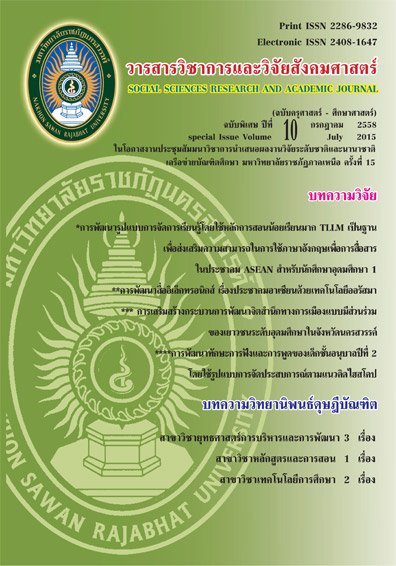การพัฒนารูปแบบการจัดการเรียนรู้โดยใช้หลักการสอนน้อยเรียนมาก TLLM เป็นฐานเพื่อส่งเสริมความสามารถในการใช้ภาษาอังกฤษเพื่อการสื่อสารในประชาคม ASEANสำหรับนักศึกษาระดับอุดมศึกษา; Development of Instructional Model Based on Teach Less Learn More Principles
Main Article Content
Abstract
บทคัดย่อ
การวิจัยนี้มีวัตถุประสงค์เพื่อ 1. เพื่อสร้างและหาคุณภาพรูปแบบการจัดการเรียนรู้โดยใช้หลักการสอนน้อยเรียนมาก (TLLM) เป็นฐานเพื่อส่งเสริมความสามารถในการใช้ภาษาอังกฤษเพื่อการสื่อสารในประชาคม ASEAN สำหรับนักศึกษาระดับอุดมศึกษา 2) ทดลองใช้และศึกษาผลการใช้รูปแบบ โดย 2.1) เปรียบเทียบความสามารถในการใช้ภาษาอังกฤษเพื่อการสื่อสารก่อนและหลังการจัดการเรียนรู้ตามรูปแบบที่พัฒนา 2.2) เปรียบเทียบความสามารถในการใช้ภาษาอังกฤษเพื่อการสื่อสารหลังการจัดการเรียนรู้ตามรูปแบบที่พัฒนากับเกณฑ์ร้อยละ 70 และ 3) ศึกษาความพึงพอใจของนักศึกษาที่มีต่อการเรียนการสอนตามรูปแบบที่พัฒนาขึ้น กลุ่มตัวอย่างที่ใช้ในการวิจัยเป็นนักศึกษาระดับปริญญาตรีชั้นปีที่ 1 มหาวิทยาลัยราชภัฏพิบูลสงคราม จำนวน 45 คน เครื่องมือที่ใช้ในการวิจัยได้แก่ แผนการจัดการเรียนรู้จำนวน 10 แผน แบบทดสอบวัดความสามารถในการใช้ภาษาอังกฤษเพื่อการสื่อสาร และแบบสอบถามความพึงพอใจต่อการจัดการเรียนรู้ตามรูปแบบที่พัฒนาวิเคราะห์ข้อมูลโดยใช้ค่าเฉลี่ย () ส่วนเบี่ยงเบนมาตรฐาน () สถิติการทดสอบ t – test Dependent Sample
ผลการวิจัยพบว่า
1) รูปแบบการการจัดการเรียนรู้โดยใช้หลักการสอนน้อยเรียนมาก (TLLM) เป็นฐานเพื่อส่งเสริมความสามารถในการใช้ภาษาอังกฤษเพื่อการสื่อสารในประชาคมอาเซียนสำหรับนักศึกษาระดับอุดมศึกษามีองค์ประกอบ5 องค์ประกอบ ได้แก่ หลักการ วัตถุประสงค์ เนื้อหา กระบวนการจัดการเรียนรู้ และการวัดและประเมินผล ผลการตรวจสอบคุณภาพรูปแบบโดยผู้ทรงคุณวุฒิ พบว่า รูปแบบการเรียนการสอนที่พัฒนาขึ้นมีคุณภาพอยู่ในระดับดี 2) ผลการทดลองใช้รูปแบบการจัดการเรียนรู้ พบว่า นักศึกษามีความสามารถในการใช้ภาษาเพื่อการสื่อสารหลังการทดลองสูงกว่าก่อนทดลองอย่างมีนัยสำคัญทางสถิติที่ระดับ .05 3) นักศึกษามีความสามารถในการใช้ภาษาเพื่อการสื่อสารหลังการทดลองสูงกว่าเกณฑ์ที่กำหนดร้อยละ 70 และ 4) นักศึกษามีความพึงพอใจต่อการเรียนการสอนตามรูปแบบการจัดการเรียนรู้ที่พัฒนาขึ้นอยู่ในระดับมาก
Abstract
The purpose of this research are1) to develop and assess the quality of the model 2. implement the developed instructional model in order to 2.1) compare students’ English competency before and after attended the activities 2.2) compare students’ English competency after attended the activities with 70 % criteria 3) investigate the satisfaction of the students towards the developed model.
The samples in this research were one class of the freshmen from the faculty of education, PibulsongkramRajabhat University in first semester of 2014 academic year. There were 45 students by purposive sampling technique. The instruments used for data collection were ten TLLM lesson plans, communicative competence test, and satisfaction questionnaires. Descriptive statistics such as means, standard deviations were computed, and t-test dependent was used to compare pretest and post-test means.
The findings were as follows.
1. The developed model consisted of 5 components; principles, objectives, contents, instructional procedures, assessment and evaluation. The quality of the model checked by experts was good. The results of the experiment showed that the teaching and learning through the activities following the stage was smooth.
2. The students’ achievement after the intervention was significantly higher than before at 0.05.
3. The students’ achievement after the intervention was higher than 70% criteria.
4. The level of satisfaction towards the learning management was at a high level.


